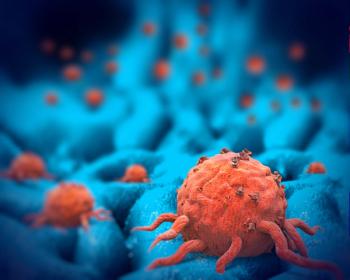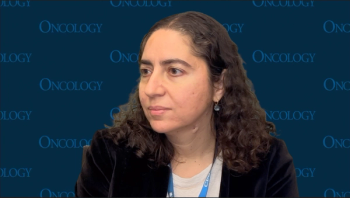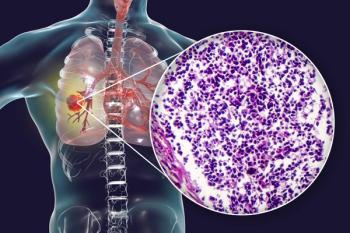
- ONCOLOGY® Companion, Volume 39, Supplement 5
- Issue 5
- Pages: 6-8
Treatment Options and AE Considerations in First-Line EGFR+ NSCLC
Experts discuss shifting preferences in EGFR-mutated NSCLC treatments, highlighting new survival data from the FLAURA2 and MARIPOSA trials shared at ELCC 2025.
The debate between osimertinib (Tagrisso) or amivantamab-vmjw (Rybrevant) plus lazertinib (Lazcluze) for EGFR-mutated non–small cell lung cancer (NSCLC) is ongoing. However, with recent overall survival (OS) data from the European Lung Cancer Conference (ELCC) 2025, the preference for one regimen over another may be shifting.
As part of a CancerNetwork-hosted Frontline Forum, a panel of lung cancer experts met at the conference to discuss the phase 2 FLAURA2 trial (NCT04035486) and the phase 3 MARIPOSA trial (NCT04487080).1,2 The FLAURA2 regimen has long had better efficacy and tolerability, but results from MARIPOSA at ELCC show an improved OS response, and the panelists were impressed.
The panel was led by Hatim Husain, MD, a professor of medicine at the University of California San Diego Health. He was joined by Roy S. Herbst, MD, PhD, Ensign Professor of Medicine and Professor of Pharmacology, deputy director of the Yale Cancer Center, chief of hematology/medical oncology at Yale Cancer Center and Smilow Cancer Hospital, assistant dean for translational research, and program director of the Master of Health Science-Clinical Investigation Track at Yale School of Medicine; Vamsidhar Velcheti, MD, director of thoracic medical oncology at New York University Langone Perlmutter Cancer Center; Martin Dietrich, MD, PhD, assistant professor of internal medicine at the University of Central Florida, and a medical oncologist at Cancer Care Centers of Brevard, The US Oncology Network; and Misako Nagasaka, MD, PhD, associate professor in the Division of Hematology/Oncology in the Department of Medicine at the University of California Irvine School of Medicine. The panelists discussed the trial results, adverse effects (AEs), and gaps in education that should be addressed.
NCCN Guidelines
To begin, the panel discussed what the NCCN guidelines prefer for first-line therapy.3 Husain noted that this was “interesting,” as it was broken down for EGFR mutation. Osimertinib is Category 1, preferred for patients with an EGFR mutation discovered before the first line of therapy. Other recommendations include amivantamab plus lazertinib and osimertinib plus pemetrexed plus cisplatin or carboplatin. For those with an EGFR mutation discovered after the first line of therapy, osimertinib or amivantamab plus lazertinib is preferred after completion of planned systemic therapy, including maintenance of interruption.
Velcheti voiced that the second option for NCCN guidelines was not an unreasonable choice based on what he has observed in his clinical practice. Dietrich noted the recommendation was vague because it would help fit the mold of different scenarios. Additionally, Nagasaka added that if next-generation sequencing (NGS) were not returned, most patients were started on chemotherapy and, in certain scenarios, immunotherapy as well. At the point she finds out the patient has an EGFR mutation, she would drop the immunotherapy and switch to an EGFR tyrosine kinase inhibitor (TKI).
“We do see more in the real world: Patients don’t get profiled, or clinicians don’t want to wait [for NGS]. Of course, you should start with chemotherapy alone at that point because the chemotherapy plus immunotherapy would delay you at least 4 to 6 weeks from starting the TKI. For the [NCCN option for EGFR mutation before the first line], if it is discovered and someone’s on chemotherapy, I’d probably just add osimertinib,” Herbst said. Although the NCCN statement is vague about treatment for patients with an EGFR mutation discovered during the first line of therapy, Husain was interested to see whether future versions of the guidelines would become more specific.
With new data coming out for the FLAURA2 and MARIPOSA
regimens, the panel was interested to see how the NCCN would determine which treatments would remain preferred or be upgraded in that space. Herbst mentioned that an asterisk should be used in the guidelines to indicate what the survival was compared with other regimens.
After the updated results from ELCC, Dietrich believed amivantamab plus lazertinib would be upgraded to a more preferred category. He wondered whether osimertinib would maintain its current standing or find a new place in the lung cancer space.
FLAURA2 Trial
This trial randomly assigned patients 1:1 (n = 557) to either osimertinib at 80 mg daily plus 500 mg/m2 of pemetrexed plus carboplatin at area under the curve 5 or cisplatin at 75 mg/m2 every 3 weeks or the osimertinib maintenance arm at 80 mg daily plus pemetrexed every 3 weeks. Follow-up was conducted with RECIST v1.1 assessment at 6 and 12 weeks and then every 12 weeks until the RECIST v1.1 criteria defined the radiological disease progression or other withdrawal criteria were met.
The progression-free survival (PFS) full analysis set analyzed both investigator and blinded independent central review (BICR). In the osimertinib plus platinum and pemetrexed group by investigator assessment, the median PFS was 25.5 months (95% CI, 24.7-not calculable [NC]) vs 16.7 months (95% CI, 14.1-21.3) in the osimertinib monotherapy group (HR, 0.62; 95% CI, 0.49-0.79; P < .001). At 24 months, the PFS rate in the osimertinib combination arm was 57% vs 41% in the osimertinib monotherapy arm.
The median PFS by BICR was 29.4 months (95% CI, 25.1-NC) vs 19.9 months (95% CI, 16.6-25.3) in the osimertinib monotherapy arm (HR, 0.62; 95% CI, 0.48-0.80). At 24 months, the PFS rate was 62% vs 47%, respectively.
For patients with central nervous system (CNS) metastases at baseline, the median PFS in the osimertinib combination arm was 24.9 months (95% CI, 22.0-NC) vs 13.8 months (95% CI, 11.0-16.7) in the osimertinib monotherapy arm (HR, 0.47; 95% CI, 0.33-0.66). For those without CNS metastases at baseline, the median PFS was 27.6 months (95% CI, 24.7-NC) vs 21.0 months (95% CI, 16.7-30.5) in each arm, respectively (HR, 0.75; 95% CI, 0.55-1.03). Herbst noted that these results were “the most compelling.”
At the second interim OS analysis, the median OS was not reached in the osimertinib combination arm (95% CI, 38.0-NC) vs 36.7 months (95% CI, 33.2-NC) in the monotherapy arm (HR, 0.75; 95% CI, 0.57-0.97; P = .0280). Between the combination and monotherapy arms, the OS rates were 92% vs 89% at 12 months, 80% vs 72% at 24 months, and 64% vs 50% at 36 months.
The HR led to some buzz among the panel about the potential of patients crossing over from the monotherapy to the combination arm. Husain said he researched this prior to the discussion, and 50% of patients in the monotherapy arm went on to receive chemotherapy. Regarding AEs, the most common grade 3 or higher AEs in the combination and monotherapy arms included anemia (20% vs < 1%), diarrhea (3% vs < 1%), nausea (1% vs 0%), decreased appetite (3% vs 1%), and constipation (< 1 vs 0%).
MARIPOSA Trial
Patients were randomly assigned 2:2:1 (n = 1074) to either amivantamab plus lazertinib at 1050 mg (or 1400 mg with weight of 80 kg or more) weekly for the first 4 weeks then every 2 weeks (n = 429), osimertinib monotherapy at 240 mg daily (n = 429), or lazertinib monotherapy at 80 mg daily (n = 216). Updated results from the conference showed a median OS that was not reached (NR) in the amivantamab/lazertinib arm (95% CI, 42.9-NR) vs 36.7 months (95% CI, 33.4-41.0) in the osimertinib monotherapy arm (HR, 0.75; 95% CI, 0.61-0.92; P < .005). Between each arm, the OS rates were 75% vs 70% at 24 months, 60% vs 51% at 36 months, and 56% vs 44% at 42 months.
For Herbst, these results from the conference were “better than expected.” Additionally, the curve showed separation at the end. Velcheti pointed out that at 36 months, there was a plateau, which is unlike something they have seen with other targeted therapies before.
“For MARIPOSA and FLAURA2, there was a big subset of patients who couldn’t get to second-line [therapy]. It’s important to consider these OS data now to look at the patients whom we should be thinking about differently. Maybe we should be considering a combination up front and then more of an opt-out strategy in patients whom we can’t give the combination. Maybe those are the patients who would be getting single-agent monotherapy. The other thing that I wanted to add was that the osimertinib monotherapy median OS is identical. I think that speaks to the reliability of the data,” Nagasaka said.
At the median follow-up, the median intracranial PFS was 25.4 months (95% CI, 20.1-29.5) in the amivantamab/lazertinib arm vs 22.2 months (95% CI, 18.4-26.9) in the osimertinib monotherapy arm (HR, 0.79; 95% CI, 0.61-1.02; P = .07). The intracranial PFS rates were 51% vs 48% at 24 months and 36% vs 18% at 36 months between both arms, respectively.
The intracranial overall response rate was 78% (95% CI, 71%-84%) in the amivantamab/lazertinib arm vs 77% (95% CI, 71%-83%) in the osimertinib arm. The median intracranial duration of response was 35.7 months (95% CI, 25.8-NR) vs 29.6 months (95% CI, 23.9-34.1).
The median PFS by BICR was 23.7 months (95% CI, 19.1-27.7) in the amivantamab/lazertinib arm vs 16.6 months (95% CI, 14.8-18.5) in the osimertinib monotherapy arm (HR, 0.70; 95% CI, 0.58-0.85; P < .001). The PFS rates were 73% vs 65% at 12 months and 48% vs 34% at 24 months.
“The fact that we have an OS that’s longer than PFS speaks to the complete absence of salvage opportunity in a second-line setting. I hear the argument about second-line therapy options a lot, and it’s not reflected in any data piece here. The ratio of PFS to OS here, being a factor 1.5 or so, I find quite impressive, and it tells you that attrition and lack of subsequent line efficacy [have] an impact here and should influence how we select up-front treatment,” Dietrich said.
Any-grade AEs related to EGFR inhibition included paronychia (69% vs 30%), rash (64% vs 32%), diarrhea (32% vs 47%), and dermatitis acneiform (30% vs 13%) in the combination vs monotherapy arms, respectively. Any-grade AEs related to MET inhibition included hypoalbuminemia (51% vs 7%) and peripheral edema (38% vs 7%). Other AEs of any grade included infusion-related reaction (IRR; 65% vs 0%), alanine aminotransferase increase (40% vs 15%), aspartate transaminase increase (33% vs 16%), and constipation (31% vs 16%).
Impact of Toxicity on Quality of Life
Husain asked how communication with patients occurred regarding AEs. He wondered whether explaining that experiencing a mild IRR was a way to show the treatment was, in fact, working. Dietrich said his patients were more accepting of AEs if they understood them.
“If someone’s on the drug and they’re having the toxicity and you’re managing through it, you would say, ‘Well, that’s the drug working,’ and you give them hope. What you need to do is to say up front what the toxicities are. Patients know what to expect. Make sure the patients go home with a kit with instructions, and that’s the way to keep it in check. You’re going to have to take care of the fingers, toes, and scalp. If you have a team who can do it in the office well and they communicate and call people back, I think it’s fine,” Herbst said.
An interesting talking point was what countries outside of the US were doing to combat toxicities while also relying on effective treatment decisions. Dietrich, who was part of an Asia Pacific roundtable, discussed how skin is revered and that if someone has a toxicity that affects their appearance, it does affect quality of life. The male physicians were intrigued by the MARIPOSA data, but Dietrich noted the female physicians were more hesitant because of the skin toxicities.
Final Thoughts
As the discussion came to a close, the panelists each gave their thoughts on the topics discussed as well as what is next in the space. For Dietrich, the MARIPOSA data dominated the conference, but he still wants additional data, and measures need to be put in place regarding their application. He believes osimertinib is no longer the standard of care in this setting. He is excited about subcutaneous amivantamab and looks forward to additional OS readouts for FLAURA2.
Velcheti thinks there needs to be more education for oncology nurses because they are fielding a majority of the calls that come in when AEs are experienced. He foresees this as a potential challenge in this area.
Husain agreed with the educational component, specifically for those in the community. Community practices may need help with the organizational component, such as AE management, testing, and creating educational platforms.
For Nagasaka, she needs some more granularity on the MARIPOSA data, such as relative dose intensity. She reminded her colleagues that “it is a marathon and not a sprint”. Additionally, patients need access to supportive care, and physicians should be empowering and educating the entire team.
Herbst noted the survival data for FLAURA2 would most likely be positive, so it is only a matter of which regimen will be used first. Most clinicians are comfortable with the FLAURA2 regimen, so it will be about sharing the new information widely.
References
- Planchard D, Jänne PA, Cheng Y, et al. Osimertinib with or without chemotherapy in EGFR-mutated advanced NSCLC. N Engl J Med. 2023;389(21):1935-1948. doi:10.1056/NEJMoa2306434
- Yang JCH, Kim YJ, Lee SH, et al. Amivantamab plus lazertinib vs osimertinib in first-line EGFR-mutant advanced NSCLC. Abstract presented at: European Lung Cancer Congress 2025; March 26-29, 2025; Paris, France. Abstract 4O.
- NCCN. Clinical Practice Guidelines in Oncology. Non-small cell lung cancer, version 3.2025. Accessed May 9, 2025. https://tinyurl.com/463upsvs
Articles in this issue
Newsletter
Stay up to date on recent advances in the multidisciplinary approach to cancer.




















































































